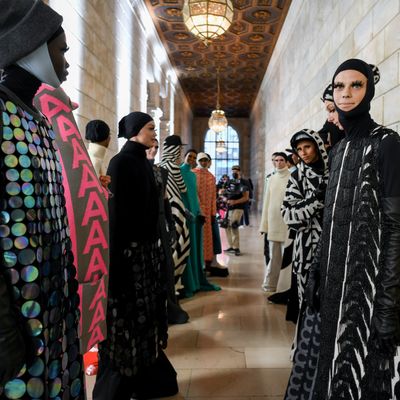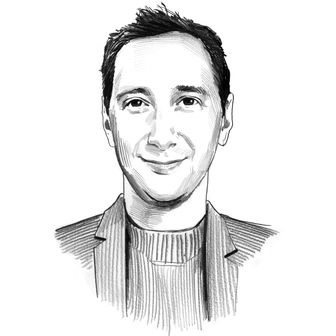
As a diagnostic category, “Fashion Week” has lost much of its oomph. When is Fashion Week and when isn’t Fashion Week is increasingly a matter of confusion, even to those of us who are tasked with covering it. (As a Vogue writer murmured to me last night, it’s always Fashion Week somewhere.) Marc Jacobs used to be the tentpole of New York Fashion Week. But last night, at the grand New York Public Library building on Fifth Avenue, the one guarded by Patience and Fortitude, Jacobs staged his own show, on his own time.
Patience, if not Fortitude, is generally anathema to fashion. But Jacobs took the opportunity the pandemic provided to decelerate, to skip a beat. His last show was 16 months ago, a Roman candle of excitement and energy in an entirely different fashion moment in an entirely different world. “Our decision to pause allowed us to slow down,” Jacobs wrote in his show notes last night, “[to] reflect, ruminate, reevaluate, grieve, and take a thorough inventory of what works, what doesn’t work, what we love, what we are willing to let go of, and what has value, importance, and meaning.”
So as the fashion week machinery cranked back up, some of it is as it has ever been — the street-style photographers waiting outside, the double-kissed cheeks, the questions about summer plans as a vaccinated industry returns to flying off to L.A. to shoot and Mykonos to tan — and some of it is different. To start, there was no week, just Jacobs showing alone on a sweltering summering evening. Jacobs’s show is usually the tip of the spear for his collections, which will then be dispersed to stores around the world, but not this one: Lately, he’s rejigged his business to angle it more toward its lower-priced lines, and this runway collection will go to just one, Bergdorf Goodman (strollers down Fifth Avenue last night could’ve caught it projected on the side of its façade), making Jacobs a kind of heir to Halston, who was for a time one of Bergdorf’s house brands. It coaxed Jacobs to a collection that feels akin to couture.
The cocooning shapes, the puffed-up volumes, and the slouchy way the models draped their coats and their faux-fur stoles made them seem like the socialites of an earlier era fluttering back through ours. But the way they slouched on their hooflike wedges, the way they dragged those stoles carelessly behind them — that’s all Marc. (For all the fashion references, the nods at the Space Age and the ’60s, I also smelled the old New York rave boutique Liquid Sky in the puddly iridescent pants, and South Park’s constantly killed Kenny McCormick in the mega hoods; that mix, too, is very Marc.)
But more than any of its references, to fashion history and to Jacobs’s own past (his collections will always have both), there was a sense of movement — that’s why, I suspect, Jacobs photographed all of the looks not head-on as usual, but from the side. Each of his models became a little vector of forward motion, and each one came out twice: the first swaddled in her (or his, or their) coats and hats and hoods and, yes, masks, and then, the second time, mostly without them. It was impossible not to see a nod at our armored, prophylactic last year in the covered-up looks of the first round, an anxiety underscored by the nervy, sawing strings of Max Richter, who composed dystopian airs for The Leftovers and Black Mirror, on the soundtrack. But it was hard not to be buoyed, too, when the models molted and reemerged, color breaking through what had begun as stark black and white. They disappeared up the library stairs, ascending, followed out by a final dress in brilliant yellow. Here comes the sun.







